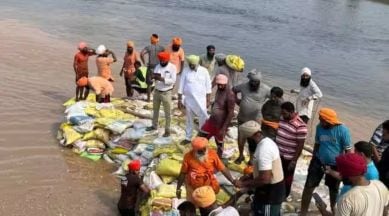Stay updated with the latest - Click here to follow us on Instagram
Punjab monsoon fury: 100 Dhussi Bandh breaches, Rs 50 crore required to plug them; poor maintenance to be blamed
A senior officer said that had the funds been allocated for repairing the bandh and constructing a pucca road (metalled road) on it, the state could have prevented floods in many areas.

They say if you build and don’t do maintenance, it will cost you dear. This is exactly what is happening in the state. Hundred breaches, including 40 major ones, have occurred on the Dhussi Bandhs (earthen embankment) in the recent rains because of poor maintenance due to which the rivers burst their banks and inundated hundreds of villages with water, leaving a trail of destruction, death and injury in over a dozen districts of the state.
Now, the government has to spend around Rs 50 crore to plug these breaches to sail in smooth waters. These extensive Dhussi Bandhs, collectively spanning hundreds of kilometres, on the rivers of Punjab have not been adequately maintained for years except some portions were repaired after the 2019 floods.
monthly limit of free stories.
with an Express account.
The illegal sand mining near the Dhussi Bandhs along the rivers which weakens the strength of the embankments and encroachments near the area have also been blamed for the breaches.
Officials in the drainage wing of the water resources department (Punjab) have stated that approximately Rs 700 crore is required to maintain the Dhussi Bandhs properly in the state. This will include widening of the bandh, raising the level from river-bed, strengthening it at various locations and constructing metalled road on it at some places.
According to the water resources department (Punjab), the breach size varied – at some Dhussi Bandhs it was just a few feet wide, while at others it was several feet wide. The embankments have been built on Ghaggar river, Sutlej river, Chitti Bein (rivulet), Beas river and on several seasonal streams.
According to the sources in the department, nearly 50% breaches have occurred on embankments along Ghaggar river, which passes from Patiala and Sangrur districts mainly and floods several blocks of these two districts because of the natural course of the river and its narrowness at several places.
In Doaba region itself the two major breaches on Dhussi Bandhs along the Sutlej and Chitta Bein have wreaked havoc in 54 villages of Jalandhar and Kapurthala districts.
Now, there are reports of breach of Dhussi Bandh in Beas river near Tarn Taran due to which some 1,500 acres of land in villages like Munda, Gujjurpur Wala, and Mand has been inundated with water.
In Gurdaspur, Deputy Commssioner Himanshu Aggarwal issued an advisory on Wednesday asking people living near Ravi River to remain vigilant after 2.6 lakh cusecs of water was released into Ujh River, which after crossing Pathankot merges into the Ravi at Makora Patan in Gurdaspur district. Water level is also rising in Ravi River and in Amritsar people are advised to stay away from the river.
Dhussi Bandh has been constructed along three perennial rivers – Sutlej, Beas, and Ravi – as well as along the east (Chitti) and west (Holy) Beins (rivulets), Ghaggar and Chaki rivers (both seasonal rivers), and 16 major choes and Nadis (seasonal streams) in Hoshiarpur, Ropar, Mohali, and Nawanshahr districts. The perennial rivers flow through around a dozen districts of the state, while the other seasonal rivers pass through most of the remaining districts.
Officials in the drainage department said that despite the government’s substantial spending on relief efforts after every flood, the affected people do not receive complete relief but only enough to survive. Following the 2008 floods, the government announced relief funds of around Rs 550 crore, and after the 2019 floods Rs 1,200 crore was spent. However, the damage suffered by the flood-hit people could not be fully compensated.
A senior officer said that had the funds been allocated for repairing the bandh and constructing a pucca road (metalled road) on it, the state could have prevented floods in many areas.
“The involvement of people from flood-affected areas is crucial in undertaking this work, as no-one wants to be uprooted every few years. Additionally, there is a significant amount of silt in the rivers that can be utilised to strengthen the bandh,” said officials on condition of anonymity.
The senior officer in the drainage department emphasised that proper action should have been taken in a timely manner, with adequate funds allocated to prevent the current situation. The department’s records can verify the amount of money released for bandh maintenance and the construction of spurs and studs, as funds are usually released when breaches occur.
Senior officials in the drainage department, while remaining tight-lipped, admitted that at present nearly Rs 700 crore is required for the repair and maintenance of the entire Dhussi Bandh – collectively some 900 km in length – along various rivers, streams, choes, and rivulets. They also mentioned that people are equally responsible for damaging the embankments by encroaching on them and indulging in illegal sand mining near that area.
The minister of water resources could not be contacted. H S Mehnditratta, Chief Engineer, Drainage Wing, said that the breach repair work is going on and some of the breaches have already been plugged.